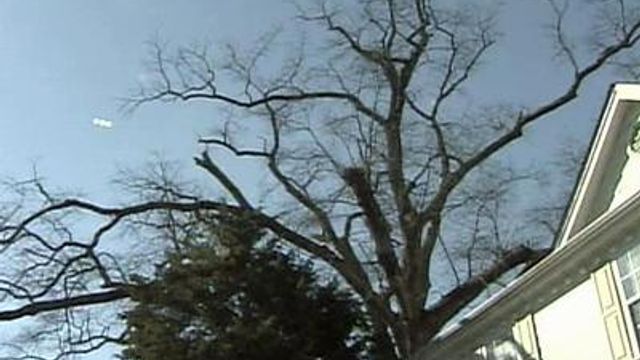RALEIGH, N.C. — Hurricanes, high winds, and ice storms: all can do damage, especially when trees topple during those events.
Who's responsible, though, when a dead tree simply begins to give in to gravity, and is there anything you can do to protect yourself? A viewer who is in the middle of that debate called 5 On Your Side for help.
Near Charles Prather’s home is a huge oak tree that looks like it's part of a haunted house.
The dead tree drops large limbs without warning. The limbs litter his back yard. One fell on his car.
More huge limbs hang over his house.
“I just want the safety issue to be taken care of,” Prather said.
The tree is on his neighbor’s property. He asked her to have it taken down and followed up with a certified letter. When she didn't do what he asked, he called the City of Raleigh, but officials told him they cannot force someone to remove a tree.
“If you have tall grass in your yard, they'll fine you for that and that's not a safety hazard. But they can't make someone take down a tree like this that really is a huge safety hazard?” Prather said.
There's no doubt that a dead tree can be a safety issue and, potentially, a legal issue.
"Any tree removal that can be done to protect liability makes sense," said attorney Laurie Howell, who specializes in real estate law.
Howell said she hears about these types of situations all the time, and it's usually much less costly for a tree owner to go ahead and remove it than to deal with problems later if something bad happens.
“Most dead trees can be removed for $500 to $1,000 dollars. That's most people's (insurance) deductible – not to mention other potential liability. If the tree falls and hits a structure or hurts an individual, can you imagine?” the lawyer said.
“I'm frustrated that people have told me that she's liable for damages, but you can't you know – if a branch comes through and hits me and injures me, money doesn't put me back together,” Prather said. "It's just very frustrating."
When 5 on Your Side contacted Prather’s neighbor to get her side of the story, she hung up on them.
Howell said that the best way to resolve a dispute like this is often for the neighbor who’s worried about the tree to pay half the cost – despite having no responsibility – just to avoid having any property damaged or anyone hurt.
The bottom line: If your neighbor’s tree is clearly dead or a danger to your property, and you notify the owner by certified letter of the danger, if that tree later falls and does damage to your property, it is the tree owner’s responsibility to pay for that damage.
However, if your neighbor's perfectly healthy, non-leaning tree, falls on your house during a storm, the damage that happens is your responsibility to clean up and repair.





